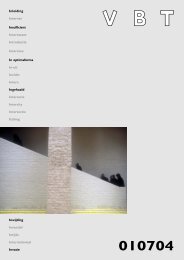Chandigarh Ahmedabad – Le Corbusier - Vereniging van ...
Chandigarh Ahmedabad – Le Corbusier - Vereniging van ...
Chandigarh Ahmedabad – Le Corbusier - Vereniging van ...
Create successful ePaper yourself
Turn your PDF publications into a flip-book with our unique Google optimized e-Paper software.
What is amiss: these ventures or our own lives? I remember being caught in New York in 1962 during the<br />
Cuban missile crisis. All over the city there was mounting alarm about possible nuclear attack, endless talk of<br />
air raids, and so forth. After three harrowing days, my wife and I decided to return to Boston. The highway was<br />
crowded with cars, jamming all the cloverleaf intersections. I was wretched. I thought to myself: Damn Sant'<br />
Elia and all those Futurists! Couldn't they see that their visions wouldn't work? We were listening to the car<br />
radio when suddenly we heard the announcement: the Russian ships had turned back! All at once we realised<br />
that America and Russia were not going to fight after all, that this marked a turning point in the cold war, that<br />
there would probably be world peace for a decade or more. It was an enchanted moment. I looked out the<br />
window at the beautiful highway intersections and the myriad cars arching gracefully through the night, red<br />
taillights aglow. Our misery, dear Brutus, lies not in our buildings, but in ourselves.<br />
We have been diminished because our perceptions have become small. We can never be bigger than the<br />
questions we define. What made the architects of the 20th century exceptional was not so much their talent as<br />
the import of the issues they tackled. For, as Stendahl wrote about Napoleon, "There are no great men, there<br />
are only great events." The attitudes and values of the 1920s, which Peter Smithson calls the "Heroic Age of<br />
Architecture", had receded: with <strong>Chandigarh</strong> they burst forth again, like an Indian summer.<br />
The venture remains unique in our minds, not only for what it accomplished but also for what it conceived of<br />
doing. This is what generated the enthusiasm and the dedication of the team around <strong>Le</strong> <strong>Corbusier</strong>. To them,<br />
the building of the city was the central fact of their lives. They gave the task everything they had. <strong>Le</strong> <strong>Corbusier</strong><br />
demanded no less. Architecture was for him a deeply moral act, and to us in India this was comprehensible;<br />
he was right. Certainly without such a commitment even architects of enormous talent can be vitiated, as<br />
witness the buildings that are going up In the Gulf today. Ironically enough, it is the poor countries of the<br />
world, like India and Bangladesh, that go to <strong>Le</strong> <strong>Corbusier</strong> and Kahn for their buildings. Rightly or wrongly, they<br />
believe that architecture is a passionate, nearly sacred, undertaking. I sometimes wonder what would have<br />
happened to <strong>Le</strong> <strong>Corbusier</strong> if he had landed a commission in the Gulf! Would he have accepted? (Remember<br />
The City of Tomorrow). And would he have survived?<br />
India was lucky to get <strong>Le</strong> <strong>Corbusier</strong>; <strong>Le</strong> <strong>Corbusier</strong> too, was lucky to get India.<br />
When all is said and done, 25 years is not such a long period; it is a mere eyeblink in history. Over the<br />
decades to come, new issues will arise and <strong>Chandigarh</strong> will have to measure up to them. Perhaps the future<br />
will be even harsher than we have been on <strong>Le</strong> <strong>Corbusier</strong>'s abilities and insights as a city planner. But to the<br />
incredible power of his architecture, <strong>Chandigarh</strong> will always bear steadfast and unique testament. His was the<br />
kind of commitment Hinduism has always respected and understood.<br />
India, in its turn, brought out the best in <strong>Le</strong> <strong>Corbusier</strong>. It was as though the warm sunlight and the lifeaccepting<br />
patterns of the people loosened up the Swiss in him. As in his earlier visit to Brazil, he changed. His<br />
buildings grew more exuberant, more tropical, which is to say they became more pluralistic, less rigidly<br />
predetermined. Old temples and cities in India (like their counterparts elsewhere) are a collection of a good<br />
many decisions -- some transparently rational, others opaque -- that makes them as equivocal, as<br />
unfathomable, as music that you want to hear again and again. Thus, perhaps, the Vedic saying, "An architect<br />
should not finish his buildings; he should know how to leave 40 per cent to God."<br />
India is an ancient land. Over the centuries there have been other new cities like <strong>Chandigarh</strong> and other<br />
prophets like <strong>Le</strong> <strong>Corbusier</strong>: Fatehpur Sikri, Patrick Geddes, Edwin Lutyens, Golconda, Mandu. Today many of<br />
them are not perceived at all as foreign elements but as an integral part of the Indian landscape. Yet when, for<br />
instance, Fatehpur Sikri was first built, it must have seemed outlandish and something landed from the moon.<br />
Today we see it as a very Indian city. For this timeless civilisation has never fretted over labels like old and<br />
new, indigenous and foreign; it establishes affinities far more fundamental than that. And Hinduism has<br />
developed a truly amazing pluralistic schema where new and old, light and dark can co-exist, be absorbed,<br />
endure...<br />
India as blotting paper. Who knows? A hundred years from now, perhaps <strong>Chandigarh</strong> will also fit seamlessly<br />
into the Punjabi ethos; perhaps it will be perceived as a famous old Indian town, and <strong>Le</strong> <strong>Corbusier</strong> will be<br />
acknowledged ... as the greatest Indian architect of them all?<br />
["<strong>Chandigarh</strong>: the view from Benares", reprinted with permission from the author ]<br />
27 / 27






